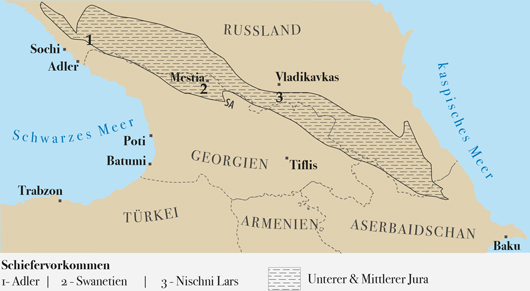|
The slate deposits in the Caucasus Mountains
(Russia, Georgia)
Together with the Alps and the Himalaya, the Caucasus builds the largest mountain chain of the world. The Caucasus comprises the Greater Caucasus in the North which has an alpine character.
All slate deposits belong to Jurassic units which run through the Greater Caucasus. Slate mining was done on a low level.
The sediments for the Caucasian slates deposited on the Great Caucasian island arc
The Variscan orogeny and Eo-Cimmerian-Early Alpine events did not lead to the complete closing of the Palaeozoic Ocean. The last phase of the collision during the Neogene-Quaternary period lead to the generation of the Jurassic slates.

Overview of potential slate mining locations (Schiefervorkommen = slate deposits; Unterer & Mittlerer Jura = Lower & Middle Jurassic).
The Greater Caucasus is a fold-thrust belt which is bordered by the Scythian Platform to the north and comprises Mesozoic marine sediments. The southern Lesser Caucasus is separated from the Greater Caucaus by the Kura-Aras Lowland.
The Central Greater Caucasus can be divided into three distinct zones: the Front Range, Main Range and the Southern Slope while the slate deposits belong to the Main Range. The
Main Range Zone consist of a complex of crystalline schists and gneisses as well as granites and metavolcanic series. The domes and swells formed by crystalline rocks are separated by narrow, steep graben-synclines filled by Lower Middle Jurassic black slates with some intermediate and felsic volcanics.
In Svanetia, the Lower Middle Jurassic rocks are conformably overlain by a thick Upper Jurassic-Cretaceous-Lower Paleogene flysch series. Mostly during Late Miocene, the entire complex was intensely deformed, leading to narrow isoclinal folds which are divided by overthrusts with a general southern vergence.
Sotchi Adler:
The slate belongs to the Akhtsu massif which ranges between the valleys of the rivers Sochi and Psou, comprising mainly Jurrasic limestones but also Cretaceous rocks. The Lower-Middle Jurassic rocks at Krasnja Poljana can be subdivided into four formations of the Krasnaya Polyana series.
North Ossetia-Alania:
North Ossetia-Alania is a Republic of Russia and lies immediately north of the eastern part of the Greater Caucasus Range.
The most famous evidence of using slate is the necropolis of Dargavs which lies about 10 km north west of the slate deposits of Nizhniy Lars. There is only very little information of the history and statements of the time of the first crypts range from the 12th century to the 16th century. Virchow (1883) describes it as the necropolis of Koban and he was told during his visit that it was used until around 1850.
The slate deposit belongs to the northern limb of the Dar' yal-Bogos anticline which is divided in nappe structures. The slate deposits belong to the Lower Jurassic 'Kistinka Formation', comprising sandstone and siltstone. They are situated within the southermost nappe, showing subvertical south dipping structures and a well developed cleavage.
Pictures
Please move over thumbs to see larger photographs.
|

